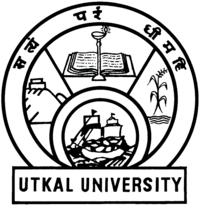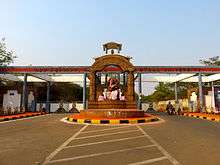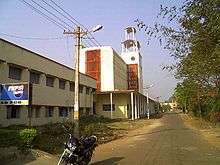Utkal University
| ଉତ୍କଳ ବିଶ୍ଵବିଦ୍ୟାଳୟ | |
 | |
| Motto |
सत्यम् परम् धीमहि (Satyam param dhīmahi) (Sanskrit) |
|---|---|
Motto in English | Seek The Highest Truth |
| Type | Public |
| Established | 1943 |
| Chancellor | S. C. Jamir, Hon’ble Governor of Odisha |
| Vice-Chancellor | Dr. Ashok Kumar Das[1] |
| Students | Over 3000 |
| Location |
Bhubaneshwar, Odisha, India 20°18′14″N 85°50′23″E / 20.303961°N 85.839647°ECoordinates: 20°18′14″N 85°50′23″E / 20.303961°N 85.839647°E |
| Campus | Urban, 399.9 acres (1.618 km2) |
| Affiliations | UGC |
| Website | www.utkaluniversity.ac.in |
Utkal University (ଉତ୍କଳ ବିଶ୍ୱବିଦ୍ୟାଳୟ), also known as Vani Vihar is the oldest university in Odisha and the 17th oldest university in India located in Bhubaneswar, Odisha. It is a teaching-cum-affiliating university. There are at present 27 masters departments at the university campus for studies and research in various disciplines of Science, Humanities, Business administration, Social science, Law, and Commerce. There are about 3000 students in the masters departments in the university. This is the largest affiliating university in the country with 267 affiliated general colleges, 15 law colleges, 6 medical and pharmacy colleges.

History


After the separation of Odisha from Bihar and the creation of the new province of Odisha in April 1936, there was a strong desire among the leaders of the province for the establishment of a separate university in Odisha. Until 1936 all the colleges were under the jurisdiction of either Patna University or Andhra University. Subsequently the government of Odisha, with Shri Biswanath Das as the premier, appointed a committee on March 2, 1938, with Pandit Nilakantha Das as its chairman to examine the possibility of establishing a separate university in Odisha. During the premiership of Maharaja Krushna Chandra Gajapati, who played a pioneering role in the establishment of the university, the recommendation of this committee was made available. Pandit Godavarish Mishra, the then minister of education in the government of Odisha introduced the Utkal University Bill which was passed by the Odisha Legislative Assembly on June 30, 1943. On receiving the Governor's assent subsequently on August 2, 1943, the Utkal University Act 1943 came into force, clearing the way for the foundation of the university on November 27, 1943.
In 1966 that Act was repealed and a new Utkal University Act came into effect from January 1, 1967. Initially Utkal University was operating from the Ravenshaw College, before it came to its own campus at Bhubaneswar, called Vani Vihar. Ravenshaw College remained affiliated to Patna University even after the separation of Odisha from Bihar in 1936; the affiliation was finally transferred to the newly created Utkal University in 1943. In fact, it was Ravenshaw College that gave birth to the new university, nursed and sustained it. It operated from Ravenshaw College's present Zoology Department building premises. The University has many departments from Anthropology to Zoology, for post-graduate teaching.The foundation stone of the present campus was laid by Dr. Rajendra Prasad, the first President of India on January 1, 1958, and the campus was inaugurated by Dr. Sarvepalli Radhakrishnan, the second President of India on January 2, 1963.[2]
Location
The campus is at the heart of Bhubaneswar city and right on NH-5. It is nearly 5 km from both the main railway station at Master Canteen and bus stand at Baramunda. All the Postgraduate departments and the law college are inside the campus.
Evolution of the Postgraduate Departments
The initial "Utkal University Act – 1943" did not specify clearly the territorial jurisdiction of the university. However its jurisdiction was extended to include the princely states in Odisha by an agreement between the rulers of these princely states and the Government of Odisha. According to the agreement adequate representation of the princely states in the administrative and academic bodies of the university (15 members in the Senate, one member each in the Syndicate and the Academic Council) was granted. The Utkal University Act 1943 was accordingly amended in 1947 defining the territorial jurisdiction of the University which was subsequently extended further to the whole State of Odisha in 1950.
Prana Krushna Parija, principal of Ravenshaw College, Cuttack was the first vice-chancellor of the university. V. V. John, the assistant professor of English in Ravenshaw College was the first registrar. The university, to start with, functioned mainly as an affiliating body. In 1949, it took over the management of the undergraduate department of law from Ravenshaw College, Cuttack, and established its first constituent college now known as Madhusudan Law College, Cuttack.
In 1956, the second phase of its expansion began with the opening of the post-graduate Department of Geology in Ravenshaw College campus and the University College of Engineering, Burla, Sambalpur. A research department of Rural Economics and Sociology was started the same year with a generous grant from the Ford Foundation. In 1957, two new post graduate departments in Philosophy and Sanskrit were established on the premises of the Burdwan House at Cuttack. That year the university office was shifted to the Circuit House at Cuttack. The University in the initial phases provided new facilities for post-graduate studies only in those subjects which did not exist in Ravenshaw College at that time.
In 1958, the post-graduate departments of Psychology, Statistics, Political Science, and Anthropology were established. While the first three departments were housed on the premises of Ravenshaw College, the Department of Anthropology was accommodated in a rented house at Bhubaneswar. The University took over the Post-graduate Department of History from Ravenshaw College in 1959. Post-Graduate studies in Zoology and Commerce were introduced in 1960 and 1962 respectively. The Research Department of Rural Economics and Sociology was established in 1956 and started Post-Graduate courses in Applied Economics in 1963. It was subsequently renamed as the Department of Analytical and Applied Economics. Around that time, a movement for the creation of regional universities started in different parts of Odisha. Accordingly, the Government of Odisha appointed the State University Committee in 1962 with Dr. P. Parija, the then Vice-Chancellor of Utkal University as the Chairman.

On the recommendation of the Committee, two more universities were created; one at Sambalpur and the other at Berhampur. The Utkal University Act-1943 was, in consequence, suitably amended to meet the new situation. The two new universities at Sambalpur and Berhampur came into existence with effect from January 1, 1967; the date from which the new Utkal University Act came into force. The jurisdiction of Utkal University, which earlier covered the whole state of Odisha, was redefined in the new legislation. After the establishment of the two new Universities, the management of the evening colleges at Cuttack, Bhubaneswar, Sambalpur and Berhampur were taken over by the State Government. The Engineering College at Burla was handed over to Sambalpur University. Utkal University, in its new campus at Vani Vihar, opened few other Post-Graduate departments such as Mathematics, Physics, Chemistry, Botany, Oriya and English during the years 1966–69. The Department of Sociology and Labour Welfare was started in 1970, which in 1974 was split into the Department of Sociology, and the Department of Labour Welfare (now renamed as the Department of Personnel Management and Industrial Relations). The Department of Geography was opened in 1970. The Post-Graduate Department of Law (L.L.M.) was started in 1973.
The Department of Geology, which was accommodated earlier in Ravenshaw College was shifted to Vani Vihar in 1977. Then the department of Library and Information Science and that of and Political Science Departments respectively, besides the 27 regular Post Graduate Programmes, along with Business Administration were opened in 1981 and in 1984 respectively. A Computer centre was established initially with different departments of the University. IBM-1130 computers were donated by the University Grants Commission in the year 1970 which has subsequently been placed by the WIPRO LANDMARK system at a cost of Rs. 16 lakh provided later by the UGC. The computer centre, while facilitating research work undertaken by various departments of the university earlier offered a Post-Graduate Diploma Course on Computer Application (DCA) from 1980 to 1997. In 1990, the university opened the Department of Computer Science and Applications.
In 1999, the university came up with integrated MCA course, which is a 5-year post-graduation course after the 12th (10+2). This course was very popular as students would got placement with multi-national companies.

In 2001, the M.Sc. Computer Science course started up which was based on entrance selection based and enrolled students must having prior computer bachelor's degree such as B.Sc. in Computer Science. This course become hugely successful with good student back ground, contemporary course structure, and excellent placement record.
The Post Graduate Department of Biotechnology was started in 2002, and offers M.Sc. in Biotechnology which is sponsored by the department of Biotechnology, Government of India, New Delhi. The Department was established by Prof. G. B. N. Chainy, the former Head of Dept. of Zoology and Biotechnology, Utkal University. Most of the modern biochemical and molecular instrumentation facilities are available here to support the research works. This Department offers Ph.D. and M.Sc. courses in different subject areas of Biotechnology.
The post graduate Department of Zoology is one of the oldest department in the University. The Department offers P.G., M.Phil. and Ph.D. courses in regular basis and M.Sc. in Fisheries as self financial 2 years course. Many eminent Zoologist had headed the Department and the research in the Department is one of the substantial output of the University. People have published their research findings in most reputed Journals such as Nature, Comp Biol Physiol, Life Sciences, Chem Biol Int, Ecotoxicol Environ Saf and J Environ Biol. This Department has published the highest numbers on international publications among all the other departments of the University. Some of the leading authors are Prof. GBN Chainy, Prof. SK Dutta, Prof. SP Bhuyna, Dr. Luna Samanta and Dr. Biswaranjan Paital. Currently due to the shortage of staffs both the teaching and research activities are greatly affected.

Superlatives
It has the largest academic campus in Bhubaneswar. It has one of the highest number of educational departments in India and is the state's largest in this respect. The integrated MCA, MBA, Law, Pharma and MFC departments are particularly of very high repute. The university has jurisdiction over nine districts in Odisha: Anugul, Cuttack, Dhenkanal, Jajapur, Jagatsinghapur, Kendrapara, Khordha, Nayagarh and Puri, catering to the needs of higher education of a population of over 11 million people. It churns out some of the best minds in eastern India and a lot of people from this place play vital role in the state and national development in the later stages of their lives.
Residential student halls
The university has separate residential accommodation for men and women students. The men's hostels include Gopabandhu Chatrabas, Madhusudan Chhatrabas and Fakir Mohan Chhatrabas,Godabarish Chhatrabas,Nilakantha Chhatrabas & Acharya Harihar Chhatrabas.
Academic and co-curricular facilities
The central library of the university is named "Parija Library" after the eminent botanical scientist Prana Krushna Parija. The Distance Education Centre is also inside the campus.
Notable alumni
- Gopal Ballav Pattanaik, ex. Chief Justice of India
- Manasi Pradhan, eminent women activist and former National Commission for Women Member
- T. K. Chand, Chairman cum Managing Director of National Aluminium Company
- Hara Prasad Mishra, biochemist based in USA
- Janaki Ballabh Patnaik, former Chief Minister of Odisha and the former Governor of Assam
- Jayanti Patnaik, member of parliament, author and editor
- Kumkum Mohanty, Odishi dancer and winner of Padma Shri and Sangeet Natak Akademi award
- Madhu Sudan Kanungo, scientist in gerontology and neuro-science and winner of Padmashree award
- Mihir Sen, first Asian to swim the English Channel in 1958, and the first swimmer to have crossed the Palk Straits in 1966
- Sarojini Sahoo, feminist writer, Sahitya Akademi award winner and editor of India AGE
- Subrata K. Mitra, political scientist and editor of Heidelberg papers of South Asia
- H R Khan, Deputy Governor, Reserve Bank of India
- Subroto Bagchi, Indian entrepreneur and a Business leader, co-founder of Mindtree
- Tapan Kumar Pradhan, activist, banker and poet
- Soumya Mishra, the first female IPS officer of Odisha
- Bhakta B. Rath, material physicist and Padma Bhushan recipient
- Loknath Behera, State Police Chief, Government of Kerala
See also
Asian School of Business Management, Bhubaneswar
References
- ↑ "Odisha Governor appointed Dr Ahok Kumar Das as new vice-chancellor of Utkal University". OrissaDiary. Retrieved 14 May 2014.
- ↑ "History".
External links
| Wikimedia Commons has media related to Utkal University. |